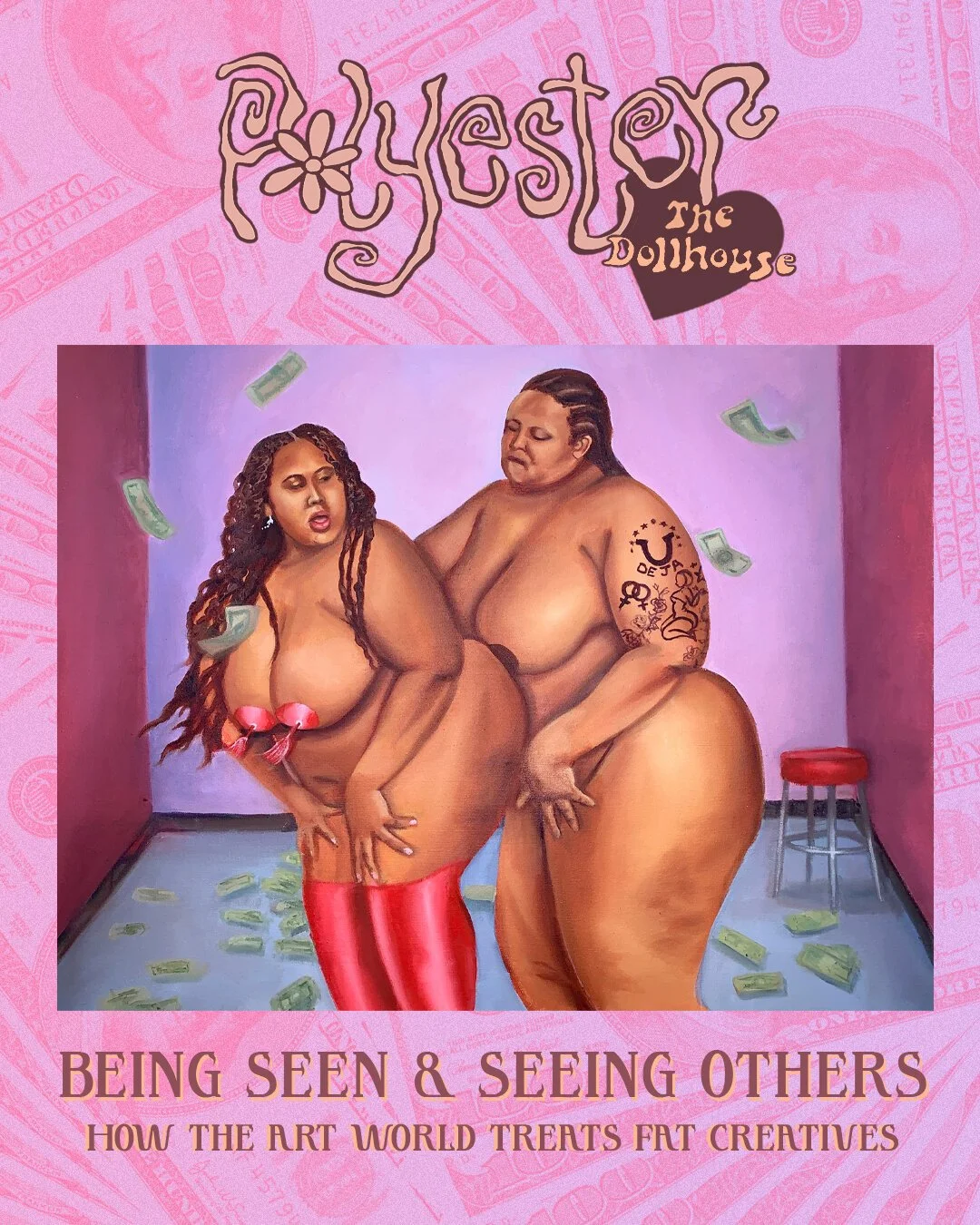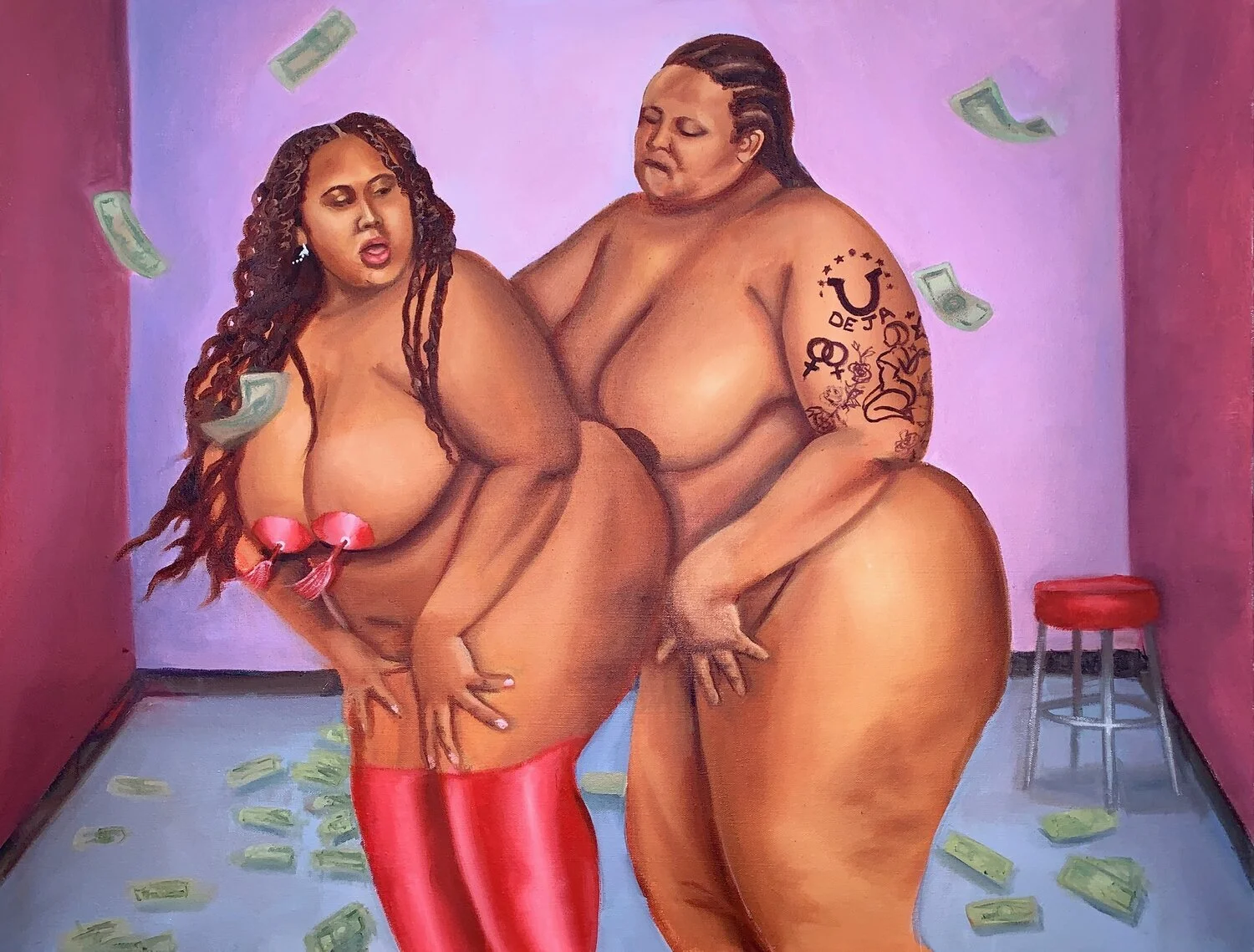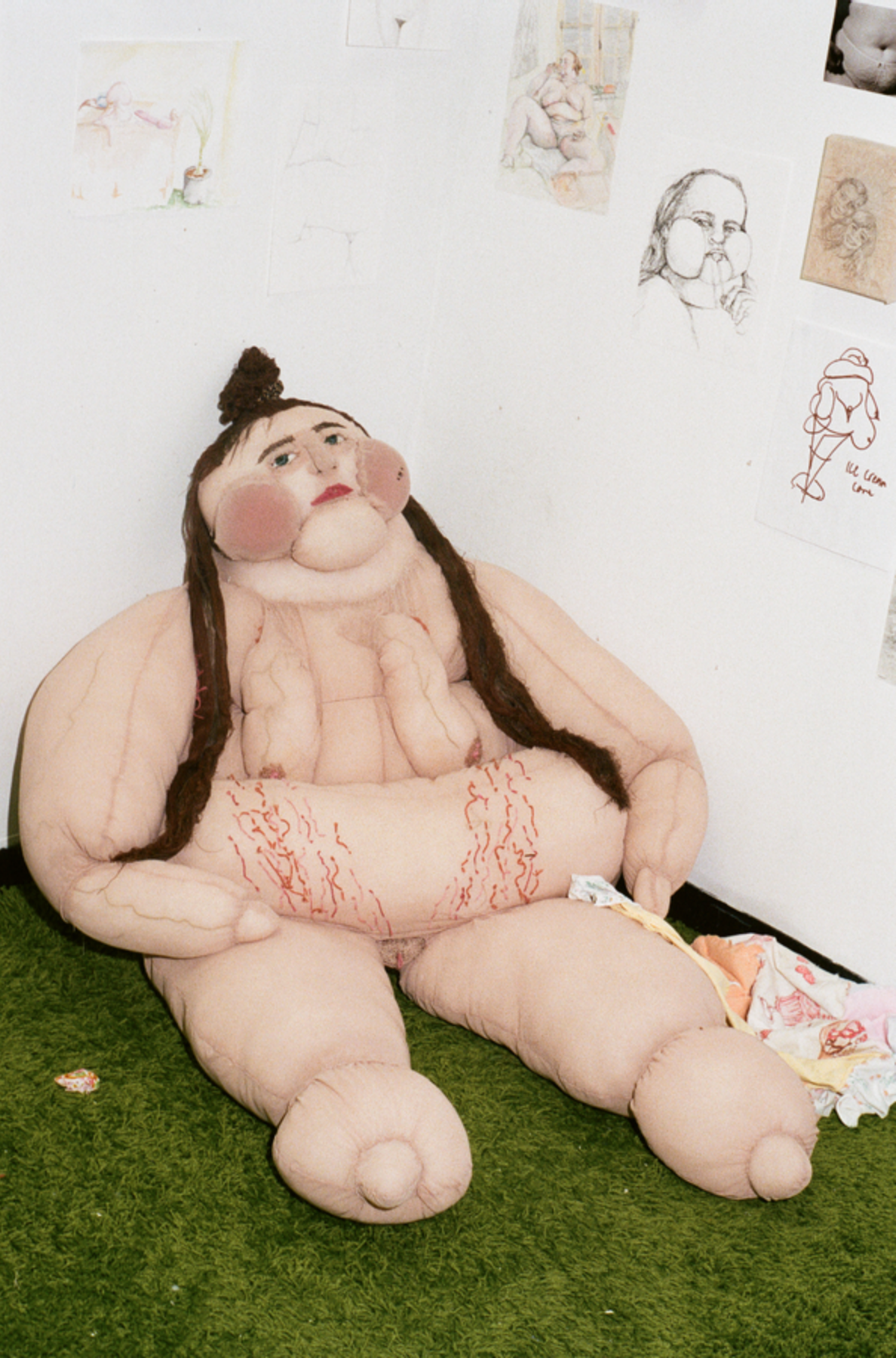Being Seen & Seeing Others: How the Art World Treats Fat Creatives
Make it stand out
“It’s important for fat artists to depict fat bodies in art. Who is better at representing us than us?” Deja Patterson, aka @wonderfullyartistic, enthuses over email. Fat art is currently having its fifteen minutes, alongside the over saturation of body positivity in the media, and arguments are breaking out alongside it. Is it fair when thin artists use fat bodies in their work not only for profit, but for the clout of being inclusive? Will fat art be a flash in the pan in terms of popularity, or is diverse body representation here to stay?
We reached out to some of our favourite fat artists for their thoughts on existing in the art world in a plus size body and creating plus size representation through their practice. The following questions were answered by Patterson, Jay Krakower, Mel Stringer, Shona McAndrew and Emily Cameron from Fat Life Drawing.
Within the art world do you find any particular pressures come specifically with being a fat artist?
Patterson: Personally, I don’t feel pressures that come specifically from the art world. However, generally speaking I feel as if there’s a lot of pressure for fat artists to be a certain way. At times, I don’t think there’s much room for me to unapologetically love myself while admitting to occasional self doubt. It’s always one or the other. Yes, I am extremely confident in myself, but I wish there was room for more vulnerability.
McAndrew: I think that anywhere in the world, people have specific expectations (or lack thereof) of fat people. It definitely took some time, both for galleries/collectors/writers to understand how to discuss and interact with both a fat artist and art that depicted fatness.
I remember a specific interaction with a writer for a big art magazine that in many ways encapsulates my experience. She told me how she loved my sculpture of me (very fat) and my boyfriend (very thin) lying naked in bed and that she was horrified that another review by a different writer had mentioned my body size, stating that I was fat in her description of the piece.
If I were to bring up the scenario to a thin counterpart, they would probably empathise with me, but they wouldn’t be able to relate. But if I were in conversation with another fat person, they would totally relate because they’ve probably been in similar situations.
The critic I was speaking with sounded so offended on my behalf, which surprised me as the piece is, in so many ways, about seeing my large naked body next to my boyfriend’s thin body. The installation was a chance to free myself from hiding my body and let the viewer confront the reality of fat bodies engaged in intimacy and love. Yet here she was, unaware that by taking such offense at the mention of my body size, she was actually the one being tone deaf.
Krakower: I know a lot of the time people are looking for me to make a general comment about fatness in my work but my main focus is my experiences as they are. I can't speak to a general experience of all fat people but I can express things I experience and if that is relatable to others then I am happy to make that connection. I think there is something powerful in just existing how you are, unchanged. That's why I focus on my existence and understanding my experiences rather than focusing on outside pressures. I do find that people are terrified of using the word fat in their gallery space though. Fat is still taken as if it is a derogatory term, yet it is really just the way people exist.
Conversely, are there any positives you find from being a fat artist that you wouldn’t have otherwise?
Stringer: The first thing that comes to mind is that I have the ability to make other plus size women feel good in their own skin when they can relate to my work, or they see themselves portrayed positively in my artwork.
Krakower: So far my experiences have been quite neutral. I get told by people that are really impressed with my vulnerability, which is something that comes along with the idea of being confident in existing in a fat body... But I love that my images resonate with the viewer and can start further conversation from others perspectives.
Patterson: Being a fat artist has allowed me to connect with so many other fat creators - especially via Instagram. I really appreciate this, because I’ve been able to join a community of like minded people who also look like me.
Oftentimes I’m the only fat person in various friend groups and there can be disconnects with them relating to certain experiences. For example, I have the hardest time fitting into standard seats on airplanes. I often have to request a seat belt extender from a flight attendant.
If I were to bring up the scenario to a thin counterpart, they would probably empathise with me, but they wouldn’t be able to relate. But if I were in conversation with another fat person, they would totally relate because they’ve probably been in similar situations. Before creating fat art and virtually meeting other fat people, I thought that these experiences were exclusive to me. But with the connections I’ve made, I’m reminded that I am not alone in navigating this fatphobic world. I also enjoy reminding others that they aren’t alone as well!
Do you feel it is especially important for fat representation in art to come specifically from fat artists, and why if so?
Cameron: It’s definitely especially important for fat representation to come from fat artists. The day-to-day experiences of fat people can’t be replicated or represented fully by artists who haven’t lived it.
As a fat person who has always loved creating and viewing art, there is something extra magical about viewing artwork that represents fatness from the perspective of someone who knows what it’s like to live in a fat body. To carry the societal and literal weight of fatness around with them every day. To create art as a fat person representing the fat experience is to say “I’m here, I’m fat, this is me, and it’s ok.” That shouldn’t be a revolutionary statement, but it still is. Fat people are still taught to hate themselves and to hide themselves - so to be visible is to be political, in a way.
Patterson: I think it’s important for fat artists to depict fat bodies in art. Who is better at representing us than us? This representation is based on our personal narratives and lived experiences. I’ve endured YEARS of body shaming from family members and acquaintances. I feel as if other fat folx have similar traumas. The creation of art that includes fat figures allows us to connect in a way that only we’d understand. Fat people have been excluded from the limelight for far too long. The art world should make space for fat creators at the forefront.
McAndrew: No matter who you are, you can only truly understand what it feels like to be you and people who share similar traits or experiences. Being fat comes with a list of insights that thin people will not even think to imagine, just like I could never imagine all the nuances to a thin woman’s experience.
In my current solo show Haven, which is showing at Chart gallery, I anchored the paintings around this notion of creating safe spaces for dialogue. In its own way, this approach definitely comes from a fat woman’s understanding of what it is like to see bodies that look like yours essentialised and mocked across all forms of media portrayed by thin actors donning fat suits in weekly sitcoms and movies (which is just one of many examples). So while I don’t necessarily think representation can only come from someone that looks similar, I do think the person or character being depicted should have a voice in the work’s production.
How do thin artists using fat bodies in their work make you feel? Is it exploitative or is it fair representation?
Stringer: I have an inner conflict when I see artwork featuring fat bodies created by a non-fat artist: It comes down to if it's done in a way that is respectful. Do they understand anatomy for plus size people? Are they just painting a stereotypical fat person? Is it fetish or exploitive? There are lots of different questions that run through my mind. I guess each case is different, but there are certainly good and bad out there.
Krakower: It is just as important to see fat people included just existing without a whole big message about their fatness as it is important to hear fat voices. I think fat voices should be amplified within the conversation about how our bodies are treated or result in the way we are treated. All that to say, a message about fatness and being a fat person is important to see and hear from a fat person. I do think there are ways to incorporate fat bodies into work done by others, I think it just depends how you do it. Dialogue is important.
Cameron: I think it really depends on the rest of their work and why they are specifically choosing to use fat bodies. If a thin artists opts to represent a broad variety of bodies in their work, featuring fat bodies, BIPOC, disabled bodies, and queer bodies - I think that’s a great thing. The more diversity, the better.
There’s unfortunately a thin line when it comes to only creating artwork of one type of body if it isn’t your type of body: It then becomes tokenistic and borders on the line of fetishism and using the fat liberation movement to gain traction that isn’t really yours.
Having said that, we need more artists in general who are able to draw fat bodies as they are - in all their glory - with reference images of actual fat people. Fat people are diverse and magnificent and deserve to be seen and celebrated in art.
How does being fat and the fat experience inspire you creatively?
Cameron: As a fat person, I’m acutely aware of my body - how it moves - how it takes up space. It’s taken me most of my 20’s to reach a point of acceptance of my own fatness, but I think that journey has shaped how I see the world. I have a huge appreciation for what my body can do for me - I have thick thighs and legs that can stomp around - I have big arms to embrace the people I love - my body has folds and marks that have changed as I have grown older, that show how I have lived my life. Fat bodies are beautiful landscapes, made of textures, colours, and shapes that are genuinely inspiring in and of themselves.
Patterson: The fat body is so beautiful. How could I not want to depict it in my work? All of the dimples, cellulite, rolls and stretch marks are all little works of art on their own. The fat body is already a masterpiece in itself and I just archive it’s beauty with my oil paint and canvas.
McAndrew: For a woman as large as myself, I have been made to feel small and insignificant too many times to count. I only came out of self hatred and a belief that I was never going to achieve anything by looking at other women and people like me who have demonstrated such a strength and awareness of who they are. I want to bring that energy into my work and hopefully be that person for someone else.
Do you think fatness in art has historically been seen as negative or positive and how - if it is - is this changing?
Cameron: I wouldn't say fatness in art is historically portrayed as either negative or positive, because I think, for most of history, fat bodies were documented in quite a specific way, mainly within portraiture and life drawing. There is, however, definitely a lot of toxicity in what we now look back upon as 'fat' historical art. Rubenesque artwork for example, is famously described as featuring fat bodies. In reality, Rubens depicted women with small, round bellies and perfect curves, which is essentially just the modern day equivalent of mainstream “body positivity”.
I think the perspective of fatness in art is rapidly changing because society is changing. Differences in body types, shapes, abilities, and skin tones are slowly being more celebrated for the very reason that they are different. I think - or I hope - that in our little corner of the art world anyway, people are more accepting of fatness as part of the fabric of life - full of beauty and grit and realness, and no more or less deserving of representation than any other body type.
Stringer: It was mostly seen as a negative in most parts of history. My whole life it's been seen as negative, and while it is still mostly seen as a negative, there are a lot more body positive artists, clothing brands, companies, collectives, models out there than there used to be. Fat bodies are more easily seen by the public eye especially if you know where to look.
Krakower: Body standards change and so does artwork. It also depends on where you are looking at work from. I don't think that I can generalize the perspective of all artwork to a negative or positive view of fat bodies. Some work is someone simply existing, and they are fat. Some work show fatness as a sign of wealth. Some work has been used to further racist thinking about fat BIPOC bodies. Some work has been done to fight back on that. Artwork is a place where people can express themselves and their views. It is so broad that I'm not sure.
And finally, what advice do you have for any aspiring fat artists in the art world?
Stringer: I'd say don't be afraid to express art that's influenced by your body. Everything you share that shows your body, whether that be artwork, videos, photos etc could possibly inspire other people to love their fat bodies as well.
Patterson: I’d say do you and forget the haters. For so long I was told I was “too provocative”. I held my work back so that I wouldn’t offend others. NEVER AGAIN. I always stick to my favourite 50 Cent lyrics: “Go head, switch the style up. If n***as hate, then let them hate, and watch the money pile up!”
Krakower: Create what you want to create. I think that focusing on what you want out of your work and exploring possibilities is wonderful. I think it is important to mess up. Do work you know you will hate to find the subjects you love. Make difficult work. Just keep working.
Cameron: You should never underestimate the power you have to inspire people: by simply existing, unapologetically, as a fat artist, you are showing the world that fat people are talented - gifted - creative. In an industry that is already notoriously difficult to break into, the very act of creating work that represents your lived experience as a fat person is a magical thing.
I think self-acceptance also has a big part to play in creating work as a fat artist - the more you embrace and accept your own fatness, the more beauty you will be able to see in your work, especially if your work depicts other fat bodies. I’d also recommend immersing yourself in the fat positive/fat liberation community on the internet! It’s a beautiful place full of accepting, empowering people.
McAndrew: You’re a capable artist like any other. You are just as worthy and strong as any artist that you look up to, and your voice is important and deserves to be heard. Find your community, artists that make work you are inspired by, peers who have similar ideas, make yourself known and have conversations with them. Comment on their posts, share their work in your stories, send them DMs, don’t be shy.
At worst you don’t hear anything back, at best you make a new friend. When looking at art, I like to ask myself ‘Why is it that this art piece was made by that particular artist?’ Who are you, what part of yourself is your work coming from. Whatever that is, be proud of it, go full steam ahead and don’t look back. You are big and beautiful and I want to know more about you.
Images (in order): Deja Patterson, Alice Bye for Fat Life Drawing, Shona McAndrew, Mel Stringer, Deja Patterson, Jay Krakower, Hana for Fat Life Drawing, Shona McAndrew







